Загадка двухдолларовой купюры
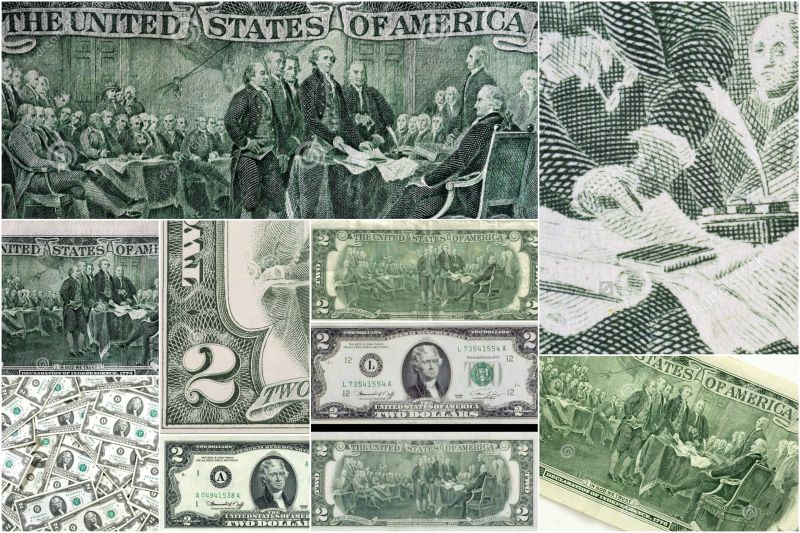
Два доллара США — банкнота США. На лицевой стороне изображён Томас Джефферсон, на обратной — репродукция картины Джона Трамбулла «Декларация независимости».
Производство купюры было прекращено в 1966 году, однако спустя 10 лет к празднованию двухсотлетия независимости США восстановлено. В наши дни новые экземпляры практически не создаются (около 1 % всех выпущенных банкнот), соответственно её редко можно увидеть в использовании. Это породило миф о том, что двухдолларовые купюры вывели из оборота, что доставляет проблемы людям, которые хотят ими расплатиться.
Редкость можно объяснить тем, что выпуск 1976 года был необычно воспринят населением (и даже стал предметом коллекционирования) и не был востребован в денежных операциях. К августу 1996 года, когда выпустили новую серию, эти банкноты уже почти исчезли.
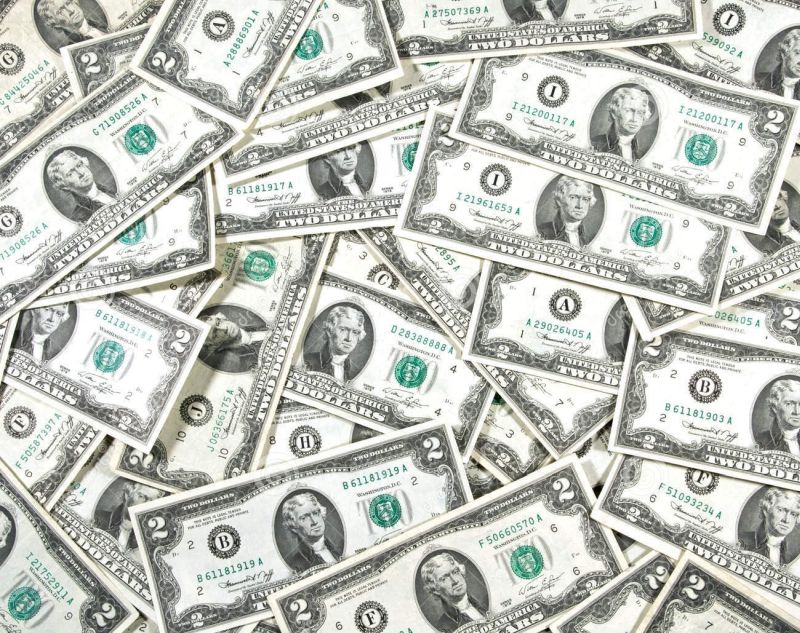
Попробуйте попросить кого-либо из друзей, отправляющихся в США, привезти вам банкноту в 2 доллара. Скорее всего, по возвращению они скажут вам, что таки вообще не видели, или — что таких не существует. Несмотря на то, что купюра в 2 доллара входит в стандартный набор купюр на протяжении всей истории США, встретить ее в свободном обороте очень сложно.
По чисто психологическим причинам эта банкнота, появившись в обращении, тут же из него изымается и перекочевывает в кошельки граждан, вывозится за границу, продается на аукционах, перепродается нумизматам.
В чем же причина? Почему купюра 2 доллара редкая? Причина, наверное — в целом ряде мифов, связанной с этой купюрой, «приносящей счастье и успех».
Двухдолларовая купюра, выпущенная в 1976 году в честь двухсотлетия США, многими коллекционерами считается редкой. Да и как не считать ее такой, если даже в серьезном справочнике «От доллара до йены. Путеводитель по валютам мира», выпущенном в 1995 году по заказу ведущих коммерческих банков, утверждается, что «двухдолларовые купюры… были выпущены в небольшом количестве, и не все американцы держали их в руках». Достоинство банкноты в два доллара является для Америки привычным — она используется в денежном обращении США с незапамятных времен. Такая купюра входила уже в набор банкнот первого выпуска, осуществленного в Филадельфии 10 мая 1775 г . Двухдолларовые купюры выпускались тогда и отдельными штатами: в Мэриленде — с 1770 году, в Нью-Йорке и Северной Каролине — с 1775 года, в Джорджии и Нью-Хэмпшире — с 1776 года и т.д. Во время 1-й Гражданской войны 1861-1865 гг. многие штаты также выпускали свои деньги, среди которых были и двухдолларовые купюры.
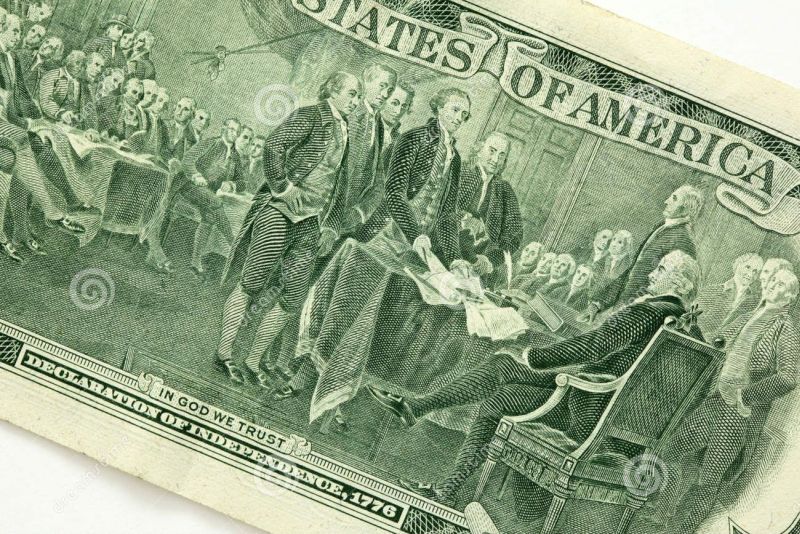
Первые двухдолларовые банкноты были выпущены Федеральным правительством США в 1862 году. На них был изображен портрет первого секретаря Казначейства Александра Гамильтона. Однако уже в 1869 году этот портрет сменился изображением третьего президента США и автора Декларации НезависимостиТомаса Джеферсона. Однако первоначально двухдолларовые купюры не пользовались популярностью у банков и у населения. Этому существует несколько объяснений, самое распространенное из которых заключается в том, что в большинстве кассовых аппаратов не было предусмотрено отдельного места для банкнот номиналом в 2 доллара. Видимо, это объяснение имеет некоторый смысл. По той же причине, скажем в ФРГ не пользовались популярностью банкноты в 5 марок.
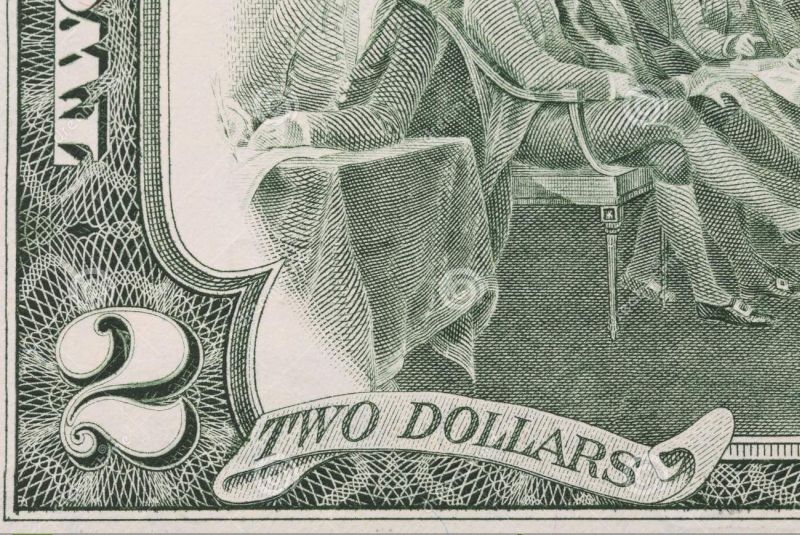
Существует мнение, что двухдолларовые банкноты было легко спутать с банкнотами номиналом 1 доллар, а это также влекло за собой некоторые неудобства. Кроме того, в народе распространилось мнение, что банкноты достоинством 2 доллара приносят неудачу. Все это привело к малой распространенности банкнот. Ситуация доходила до абсурда, когда продавцы отказывались принимать двухдолларовые банкноты в магазинах.
В странах СНГ до сих пор имеют место случаи отказа в приеме двухдолларовых купюр обменными пунктами со ссылкой на то, что нет надлежащим образом оформленного образца этих купюр, особенно — юбилейной серии.
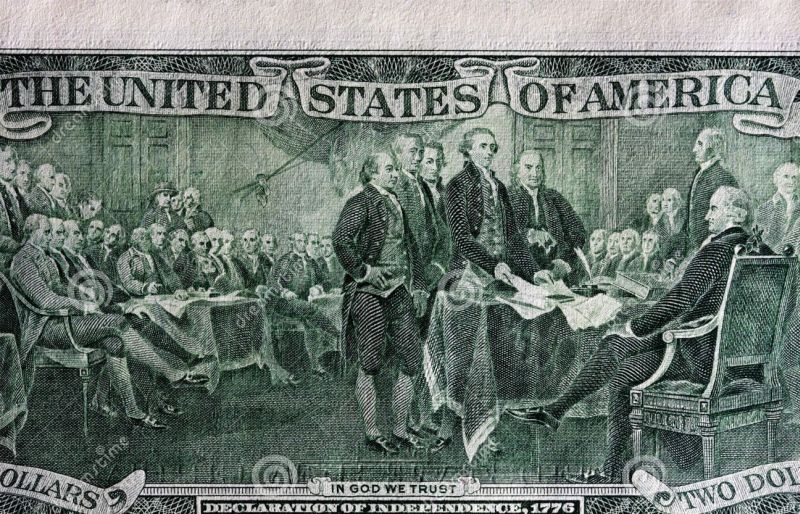
Последний раз доллар подвергался серьезной переделке в 1928 году — размеры всех купюр были уменьшены, а их внешний вид стандартизирован и с небольшими изменениями сохранился до наших дней. Среди банкнот этого типа также выпускается двухдолларовая купюра.
На ее лицевой стороне изображен Томас Джефферсон (1743 — 1826 гг.) — видный государственный и общественный деятель, «отец» Декларации независимости и 3-й президент США.
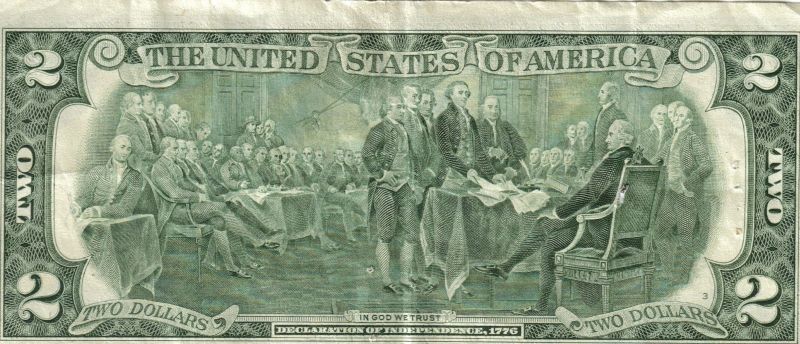
На оборотной стороне купюры образца 1928 года изображено поместье Джефферсона Монтичелло (от итальянского «Маленькая гора»). Оно было построено по его собственному проекту. Дом изобиловал различными техническими усовершенствованиями, в том числе разработанными самим хозяином. Здесь «мудрец из Монтичелло» прожил свои последние 17 лет, здесь он принимал многочисленных гостей, вел обширную переписку — свыше тысячи писем в месяц — с множеством американских и европейских политиков, ученых и общественных деятелей. Его библиотека в Монтичелло насчитывала около шести с половиной тысяч томов и была одной из лучших в Америке. Она положила начало Библиотеке Конгресса. С 1926 года Монтичелло является мемориальным музеем, национальной святыней США. Интересно отметить, что портрет Джефферсона и его поместье изображены также на лицевой и оборотной сторонах американского «никеля» — монеты достоинством 5 центов.
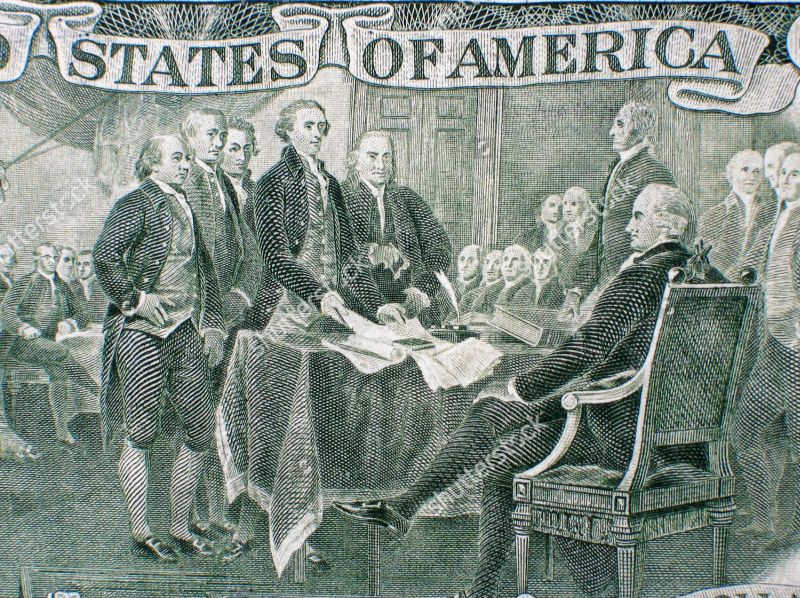
На считающейся «редкой» двухдолларовой купюре 1976 года также изображен Джефферсон. На оборотной же ее стороне изображено принятие Декларации независимости. Этот рисунок является репродукцией с картины известного американского художника Дж. Трамбулла «Подписание Декларации независимости» — одного из восьми огромных полотен, висящих в Ротонде Капитолия. На ней изображается заседание Континентального конгресса 4 июля 1776 года, провозгласившего отделение 13 североамериканских колоний от Великобритании. На картине изображен конкретный момент, когда Джефферсон вместе с четырьмя другими членами комитета по подготовке Декларации независимости передает проект Декларации президенту Континентального конгресса Хэнкоку для ее подписания (сидит в кресле справа). На картине были изображены 48 человек, на банкноте поместились только 44 из них. При этом 36 персонажей были написаны художником при жизни.
Томасу Джефферсону в момент принятия Декларации было только 33 года, таким он и изображен на картине. После этого события он прожил (день в день) еще целых пятьдесят лет, был губернатором Вирджинии, государственным секретарем, т.е. министром иностранных дел, вице-президентом, президентом (при нем, кстати, в 1808 -1809 гг . были установлены дипломатические отношения с Россией). На лицевой стороне двухдолларовых банкнот он изображен уже зрелым государственным мужем, очевидно, периода его президентства (портреты на 10 из 12 американских банкнот различного достоинства являются портретами президентов).
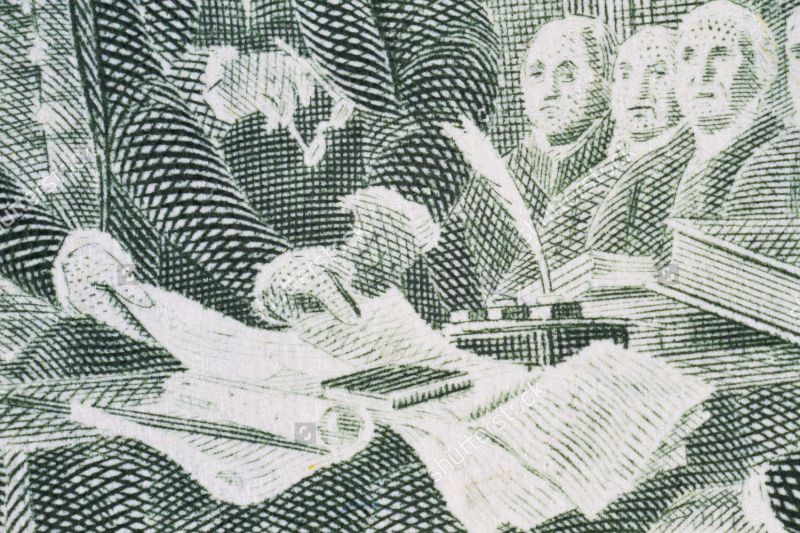
Двухдолларовая купюра 1976 года была отпечатана в миллионах экземпляров. Но, очевидно, банкноты такого достоинства чем-то не устраивают население Соединенных Штатов. Самой ходовой является однодолларовая банкнота, которая составляет 47% от общего количества всех находящихся в обращении банкнот. Ее средняя «продолжительность жизни» — всего полтора года, за это время она превращается из хрустящей купюры в мятую и рваную бумажку, которую необходимо заменить. И ежесуточно только Нью-йоркский федеральный банк уничтожает изношенных однодолларовых купюр на сумму более 35 миллионов долларов! А огромный запас невостребованных «редких» двухдолларовых купюр 1976 года бесполезно лежит в Казначействе. Очевидно, что именно эти купюры не участвуют в обращении, не изнашиваются, и соответственно, не нуждаются в замене.
Существует целый ряд легенд оносительно купюры «ту долларс». В соотвествии с одной из них, если иметь эту купюру в кошельке, то деньги не будут в нем переводиться. Другая легенда имеет некоторый сексуальный контекст. Ну а нумизматы испытывают к этой купюре уже профессиональный интерес. Ведь то, что трудно встретить в обращении, всегда привлекает внимание нумизматов.
Галерея
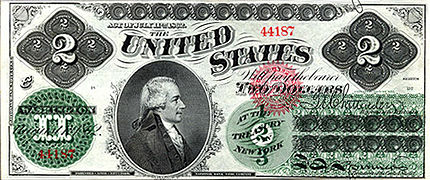
2 доллара 1862 года
.jpg)
2 доллара 1862 года (реверс)
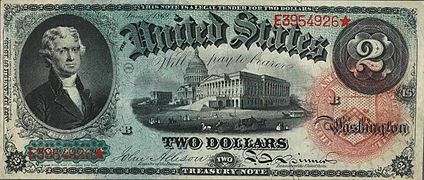
2 доллара 1869 года
.jpg)
2 доллара 1869 года (реверс)
.jpg)
2 доллара 1886 года
.jpg)
2 доллара 1886 года (реверс)
.jpg)
2 доллара 1896 года
.jpg)
2 доллара 1896 года (реверс)
.jpg)
2 доллара 1899 года
.jpg)
2 доллара 1899 года (реверс)
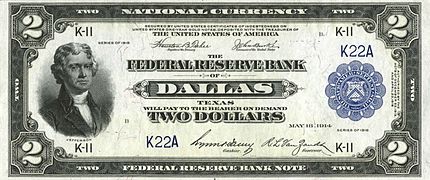
2 доллара 1918 года
.jpg)
2 доллара 1918 года (реверс)
.jpg)
2 доллара 1928 года
.jpg)
2 доллара 1928 года (реверс)
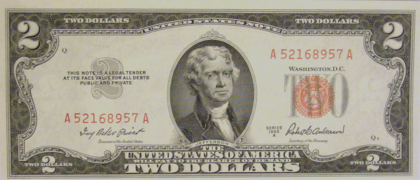
2 доллара 1953 года
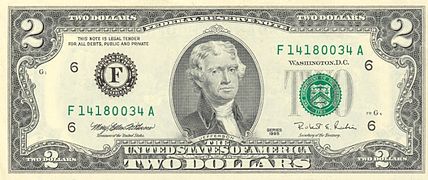
2 доллара 1953 года (реверс)
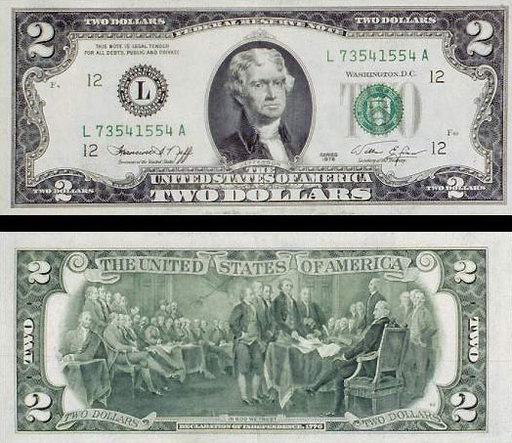
Via kaifzona.ru & wiki
Created/Updated: 25.05.2018
